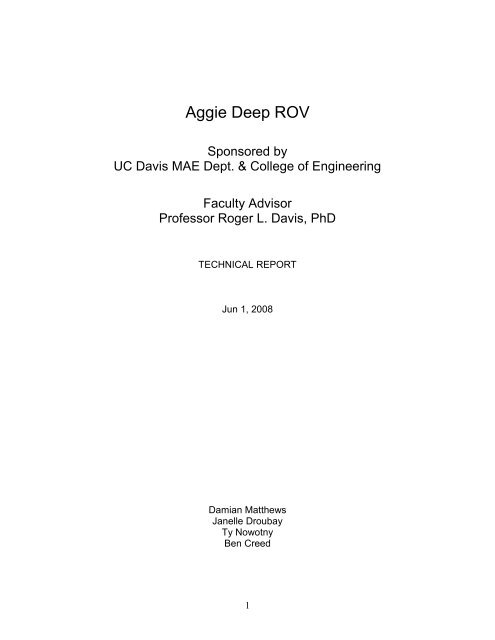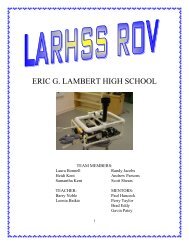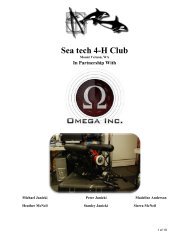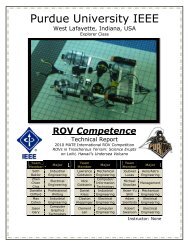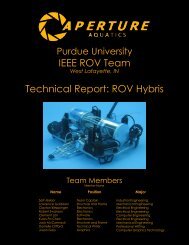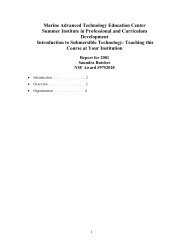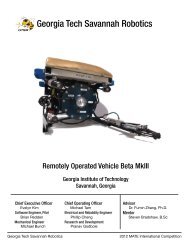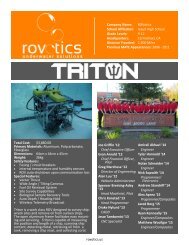Aggie Deep ROV
Aggie Deep ROV
Aggie Deep ROV
Create successful ePaper yourself
Turn your PDF publications into a flip-book with our unique Google optimized e-Paper software.
<strong>Aggie</strong> <strong>Deep</strong> <strong>ROV</strong>Sponsored byUC Davis MAE Dept. & College of EngineeringFaculty AdvisorProfessor Roger L. Davis, PhDTECHNICAL REPORTJun 1, 2008Damian MatthewsJanelle DroubayTy NowotnyBen Creed1
ABSTRACT / EXECUTIVE SUMMARYThe project objective of the <strong>Aggie</strong> <strong>Deep</strong> <strong>ROV</strong> team is the design and manufacture of aremotely operated underwater vehicle. This vehicle is to be controlled remotely by anoffshore pilot using solely the aid of onboard watertight cameras for guidance. Thevehicle is tethered to the shore by a multiple wire electrical cable carrying power, controland video signals. The vehicle gets its maneuverability from 5 mounted electricalthrusters. The <strong>ROV</strong> will compete in the 2008 MATE International <strong>ROV</strong> competitionconsisting of several scored tasks which the <strong>ROV</strong> must complete.The <strong>ROV</strong> must be able to free an obstructed scientific device from a pool floor byremoving randomly placed weights off of the device. The device has positive buoyancy,so the task will be complete when enough weights have been removed for the device tofloat to the surface. The vehicle must also have the ability to collect up to 3 of theseweights and bring them to surface for retrieval. These weights will each be 2lb bags oflead shot with no handles or tabs for easy holding. Once this portion of the competitionis complete, the vehicle is required to hover over a vertically mounted hydrothermal ventand obtain a temperature reading within 6 degrees of the actual water temperature.2
TABLE OF CONTENTSAbstract / Executive Summary ...........................................................................2ObjectivesMotivationSolution ConceptFinal Layout Drawings of Systems and Subsystems .......................................4Layout DrawingsVehicle FrameThrustersDry BoxFoam BuoyancyThermocouple ApparatusRobotic ArmCollection BinControl SystemComplete VehicleFinal Bill of Materials ..........................................................................................8ManufacturedPurchasedDesign Summary ............................................................................................... 11Basic FeaturesFunctionalityStrengths/WeaknessesConsiderations and Remaining WorkAssembly and ManufacturingChallenges ......................................................................................................... 17Lessons Learned……………………………………………………………………...18Project Management Information…………………………………………………..18Appendix / References3
FINAL LAYOUT DRAWINGS OF SYSTEM AND SUBSYSTEMSFigure 1 – Completed Vehicle (ISO Side)Figure 2 – Completed Vehicle (ISO Rear)4
Figure 3 – Vehicle Thruster, Flow Concentrator, Collection Bin and Camera SystemsFigure 5 – Vehicle Top View5
Figure 6 – Manipulator ArmFigure 7 – Vehicle End View6
Figure 8 – Upper Manipulator Arm Exploded ViewFigure 9 – Lower Manipulator Arm Exploded View7
Figure 10 – Manipulator Arm Claw and Wrist Exploded ViewBILL OF MATERIALSPARTManufacturerUnitPriceAmountNeededTotalCostFrameExtruded Aluminum: 80/20 Brand$2.76 20 55.2 1010G.A. WirthCutting Fee $1.95 5 9.75 7905Part NumberBrackets1.5x1.5x0.125 Angle 6061 T-6 Metal Craft Warehouse $1.75 48 84 A62AE1215NutsT-slot Economy Nuts G.A. Wirth $0.21 100 21 3382Socket Cap Screws; L=3/8"Thread=1/4"-20McMaster- Carr $12.91 1 12.91ControlsBatteries2006 <strong>ROV</strong> teamWiring, 10 gage, 20 ft Home Depot $16 1Tether, 75 ft 2006 <strong>ROV</strong> team 1Industrial Potentiometer Joystick Bargain Barn $4 1 4Standard Nylon Cable Ties Machine Shop 0 0Electric Slide Terminals Napa Auto Parts $7.95 2 7.95 784391100 Ohm Resistors$0.018 10 0.18 CF1/41005 RCT-ND4.7K Ohm Resistors $0.054 20 1.08 4.7KQBK-ND10K Ohm Resistors $0.016 50 0.82 CF1/410K5 RCT-ND47K Ohm Resistors $0.018 10 0.18 CF1/22K5 RCT-NDPolyfilm Box Capacitor 10nF 63V $0.085 10 0.85 478-3373-NDCeramic Radial Capacitor 100nF 50V $0.157 10 1.57 399-4264-NDElectrolytic Capacitor 100µF $0.245 10 2.45 565-2029-NDDiode GP 1A 400V DO-41 Digi-Key$0.041 10 0.41 1N4004-E3/73GI-NDSwitching Diode 75V 300MW DO-35 $0.12 20 2.4 1N4148DICT-NDTransistor BV547 45V 100MA TO-92 $0.11 20 2.2 BC547BTACT-NDP-Channel Mosfet 55V 74A TO-220AB $2.20 20 44 IRF4905PBF-NDN-Channel Mosfet 55V 49A TO-220AB $1.215 20 24.3 IRFZ44NPBF-NDQuad Operational Amplifier LM324 $0.42 10 4.2 296-1391-5-ND12K Ohm Resistor 1/4W $0.054 10 0.54 12KQBK-ND33K Ohm Resistor 1/4W $0.054 10 0.54 33KQBK-ND220K Ohm Resistor 1/4W $0.054 10 0.54 220KQBK-ND8
470K Ohm Resistor 1/4W $0.054 10 0.54 470KQBK-NDTax and Shipping 19.21IC Transceiver LP R5485 8-DIP $2.90 2 5.8 DS1487N-NDIC AVR MCU 16K 20MHz 28-DIP $4.11 4 16.44Shipping & Handling 9.6USBtinyISP AVR Programmer Kit Adafruit Industries $22.00 1 22ThrustersThrusters 2006 <strong>ROV</strong> team 0 5 0Rivabo 5-blade Propellers 65 MM,3/16mm shaft dia, type rightHarbor Models $25 4 555-065*Ducts/Cylinders: PVC Pipe, 3" dia, 4.5'longAce Hardware $5 1 5JB Weld Home Depot $4 2ATMEGA 168-20PU-NDAluminum (Thruster supports)0.25x1 Flat Bar 6061 T-6$1.10 72 79.2 A61FL2510Metal Craft Warehouse2 Dia x 0.25 RD Tube 6061 T-6 12 0 A61RT2520Underwater Silicon Sealant Tap Plastics $4.50 1 4.5O-ring Lubricant Machine Shop $0.00 0O-rings 2006 <strong>ROV</strong> team $0.00 5 0Waterproof CamerasMini Wired Color CCD Camera 2006 <strong>ROV</strong> team $0 3 0Triax Cable, 10 ft$0.00 0Heat Shrink Tubing Machine Shop$0.00 0Foam Padding $0.00 0Acrylic tubing, assorted sizes$8.10 3 8.1Acrylic caps, assorted sizes Tap Plastics$11.85 9 11.85Acrylic cement $10.50 1 10.5Multi-view soft/hardwareTBDWaterproof ThermocoupleMSI Sensors: RelativeHumidity/Temperature Module18” Long-Necked PVC Funnel, 5” diamouthCross Brace: Miscellaneous AluminumMouser.com $65.50 1 65.5 824-HTM2500Harbor Freight $2.49 1 2.49 90468-3VGAMachine ShopBuoyancy DevicesTAP X-30 Polyurethane Foam, 1/2gallon kitTy Nowotony’s PersonalSupply$0.00 1 0Dry BoxAluminum Pipe- Schedule 40; 6" 1 ft$39.90 1 39.9 640P63Aluminum Flat Bar- 8x8x1/4" ABC Supply$14.21 4 56.84 8SQ61Silicone O-Rings, Pack of 5 + Shipping Mc-Master Carr $10.28 1 28.53Nuts and Bolts Machine Shop $0.00 0Manipulator ArmBar Stock (6061-T6)0.5x2x1212 A61FL50200.375x2x12 available 12 A61FL37152x3x12 Metal Craft Warehouse upon 6 A61FL920600.1875x1x6 quote 6 A61FL12100.25x2x24 24 A61FL2520Round Stock (6061-T6)2 dia x 1212 A61RD200available3 dia x 24 24 A61RD300Metal Craft Warehouse upon0.5 dia x 6 6 A61RD050quote0.25 dia x 12 12 A61RD025Sheet Metal16 gage x 6 (.05in, 5052-H32 Al) Metal Craft Warehouse available 6 A52SA059
uponquoteThreaded Rod1/4 20 x 6 McMaster-Carr $12.90 1 12.9 93225A882Fasteners6-32UNC x 3-4 Phillips Pan HeadMachine Screw (pack of 50)$7.87 1 7.87 91500A1516-32UNC Nylock Nut (pack of 100) $5.41 1 5.41 91831A0076-32UNC x 3-8 SHCS (pack of 10) McMaster-Carr$3.71 1 3.71 92200A1468-32UNC x 5-8 SHCS (pack of 25) $6.78 1 6.78 92185A1491/4-20UNC x 1 Flat Head MachineScrew (pack of 10)$5.22 1 5.22 93085A542Rubber Covered Single Lip Shaft SealWith Spring6mm shaft dia x 16mm house bore dia x7mm width10mm shaft dia x 19mm house bore diax 7mm widthApplied.com$4.78 1 4.78 563979$3.75 1 3.75 1430534MotorsGear Head Motor- 12vdc; 50:1, 120rpm,6mm shaft$21.95 1 21.95 GHM-02Planetary Gear Motor- 12vdc; 1:231,$31.95 1 31.95 PGHM-0464rpm, 4mm shaftLynxmotion.comPlanetary Gear Motor- 12vdc; 1:241,$29.95 1 29.95 PGHM-05241rpm, 4mm shaftPlanetary Gear Motor- 12vdc; 91:1,65rpm, 6mm shaft$37.95 1 37.95 PGHM-02Commercial Miter Gear, 24 teeth, 24DP sdp-si.com $14.07 2 28.14 A 1B 4-Y24024Brass 20 Deg Pressure Angle Spur Gear24 Pitch, 12 Teeth, 0.5” Pitch Dia, 3/16”$14.46 1 14.46 7880K37BoreBrass 20 Deg Pressure Angle Spur Gear24 Pitch, 36 Teeth, 1.5” Pitch Dia, 1/4”$24.47 1 24.47 7880K44BoreSteel Ball Thrust Bearing StainlessSteel, for 3/8" shaft dia, 13/16"ODMcMaster-Carr$3.06 1 3.06 6655K35Perma-Lube Steel Ball Bearing- ABEC-1Double Sealed, No. R6 for 3/8" Shaft Da,$10.63 1 10.63 2342K857/8" ODPerma-Lube Steel Ball Bearing- ABEC-1Double Sealed, No. R4 for 1/4" Shaft Da,$14.40 1 14.40 2342K835/8" ODSample Depository Basket Home Depot TBD TBDMock OBSPVC Pipe, 0.5" Dia$3.62 1 3.62ABS Pipe, 3" $3.68 2 7.36ABS Caps $3.82 6 22.92Home DepotPVC Tee Connectors $0.27 4 1.08PVC Side Outlet Connectors $1.19 8 9.52PVC Male Adaptor Connectors $0.38 8 2.04Tax 3.67Teflon Tape$0.99 1 0.99PVC Cement Ace Hardware$4.99 1 4.99PVC Primer $4.99 1 4.99Tax 0.85Competition Traveling CostsUCSD Housing $175.00 4 700University Vehicle Rental $500.00 1 500TOTAL COST2239.0110
DESIGN SUMMARYThe basic features of our <strong>ROV</strong> design include:Vehicle FrameThrustersCamerasManipulator ArmElectronics Dry BoxFlow ConcentratorControl SystemBuoyancy DeviceTether and WiringVehicle FrameThe vehicle frame is 2x1x1.166 ft. made from anodized T-slot extruded aluminumconnected using aluminum L-shaped brackets and socket cap screws which hold theframe together in a rigid fashion. The T-slot extruded aluminum was specifically chosenby our team for its low weight to strength ratio. The slots in the extruded aluminumallow for easy attachment of vehicle components to the frame. Also, the extrudedaluminum does not have an interior air-filled region like PVC which would requirewaterproofing.The Vehicle frame has two vertical T-slotextruded aluminum crossbars affixed tothe outer right and left hand sides and onevertical crossbar centered at the vehiclesrear. These crossbars mount thethrusters for both vertical and horizontaltranslation.The use of the T-slot extruded aluminumgives great flexibility for attachment ofcomponents and easy re-configuration ofthe vehicles overall center of gravityduring testing. No problems occurredduring the construction of the vehicleframe and the T-slot extruded aluminumproved to be an excellent design choice.ThrustersThe <strong>ROV</strong> has 5 thrusters mounted to the vehicle frame using custom machinedaluminum mounts attached to the T-slot. The thruster bodies themselves arecylindrically shaped 2 inch diameter machined aluminum.11
The thrusters consist of 7 parts that include:Solid nose capHollow cylindrical bodyHollow end capSolid brass propellerPlanetary GearDriveshaftDC MotorsThe nose and end caps are fitted to thecylindrical portion of the thruster body byway of two smooth, flat-butted surfaceseach having precisely machined circularseat grooves for oiled O-ring placement.The nose and end caps are then tightlysecured to the thruster body with 4screws which are evenly placedthroughout the thruster body’scircumference. These screws, whenproperly torqued, compress the O-ringsand create a watertight fit. The brasspropeller is affixed to a rotating driveshaft- which protrudes through the end cap ofthe thruster body – and is secured with aset screw.The interior of each of the thrusters consists of a 12-volt DC motor seated snugly insidethe hollow thruster body. The anodes and cathodes are soldered to 10-AWG copperwires which protrude through two evenly spaced holes drilled into the thruster body.Both holes are sealed with JB Weld brand steel/epoxy resin for a watertight fit. The DCMotors output shaft is connected to a planetary gear-set which transfers rotationalmotion and torque to the output shaft and brass propeller. The planetary gear-set isdesigned to give the required gear reduction to step-down the motors output RPM. Theoutput shaft is tightly fitted through the end cap using a rubber lip seal which preventswater from entering the thruster housing.The thruster mounts consist of a circular 2 inch inner diameter ring - into which thethruster body is seated and held with set screws - and a flat plate attaching the ringsection to the vehicle frame. The flat plate portion bolts directly into the T-slot aluminumand can be slid along the channels to reposition the thrusters axially. This attachmentdesign is a great advantage as it allows for easy re-configuration.The ease and modularity of this axial repositioning design allows for easyreconfiguration of torque-moments about the vehicles center of gravity (COG) as well asadjustments to the COG location itself.12
The advantage of using DC motor thrusters is the ease and cost of finding reliable andpowerful motors that work well under the power restrictions given. If time and costpermitted the option of developing hydraulically powered thruster motors would beadvantageous due to problems that have arisen while attempting to keep the water out.However, were hydraulic motors to be used a separate pump solution would have to bedeveloped for the hydraulic fluid - which adds complexity. However, a hydraulic thrustersystem would have a lot less risk of failure than the electrical one chosen.Cameras3 B&W cameras are housed in clear cylindrical watertight acrylic containers. Allcameras provide closed-circuit viewing forward and aft of the vehicle for underwateroperations. Camera specs are:Camera apparatus:1/3,1/4 Picture sensorValidity Pixel: CCIR: 500 X 580 EAI: 510 X 492Sensitive area:Beaconage:Horizontal Definition:Lens:Min Illumination:S/N Ratio:4.9mm X 3.7mmCCIR/EIA420 TV LINES3.7mm/F2.0F1.2 inch , 0.05Lux>48dbShutter speed: 1/50 or 1/60 - /100,000Video output:Power supply:Power Consumption:Size:1.0Vp-p,75DC-12V90mA30mm X 30mm X 13mmThe camera configuration allows multiple views for the vehicle pilot during underwateroperations. The more camera views the pilot has at his or her disposal the better andfuture teams may want to increase the number of cameras on the vehicle if budgetsallow.Manipulator ArmThe manipulator arm is attached to the front-right-bottom of the vehicle and deploysforward during operation. The manipulator consists of 3 main parts starting with an armsection powered by a DC motor-driven actuator that swivels horizontally from thevehicle frame. At the end of the arm a joint providing vertical rotation to a forearmsection (also powered by a DC motor) is attached. The horizontal and vertical motion ofthe arm and forearm joints along with the maneuverability of the vehicle itself provide amanipulator that can be placed anywhere in 3-D space by its operator. In addition, atthe end of the forearm section a claw has been designed which will open and closeusing a jack-screw mechanism powered by another DC motor. The combinations ofmaneuverability and added claw provide a manipulator with high dexterity for carefulunderwater operations.13
All DC motors are enclosed in watertight machined aluminum housings which aresmartly integrated into the manipulator arm itself. The Manipulator is fastened to thevehicles T-slot frame with ¼ inch screws and sliding bolts for lateral-axis adjustment.The watertight motor housings are designed to withstand a depth of approximately 50feet or a pressure = 48.6 psi. The motor drive shafts will extend from the watertighthousing through a press-fit rubber shaft lip seal designed to withstand these pressures.The forearm section has a length = 1ft and has a weight ≈ 2 lbs. The motor for theforearm section provides enough power to move itself under its own weight plus theweight of a 2 lb dive weight at its end. Calculations of power requirements to maneuverthese estimations were done by our team and a Mabuchi 12-volt motor was selectedwith the following parameters:113:1 gear ratioω ≈ 142 RPM (stepped-down from 16130 at max efficiency)Torque ≈ 4 ft*lbsElectronics DryboxThe drybox is designed to house the control system onboard the vehicle. The drybox isactually a ¼ in thick 12 inch long dry cylinder made of schedule 40 6 inch aluminumpipe. Both ends of the drybox have 8 inch diameter welded flanges with highly polishedsurfaces. Both drybox flanges are fitted with 8 in diameter round flat plates fitted with1/8 inch diameter silicone O-rings 1 . The highly polished surfaces and O-rings provide awatertight seal when the flat end plates are attached using 12 bolts at each end. Thisconfiguration creates a dry interior space for electronics and electrical connectionsconsisting of 1 atm and 0.1964 ft^3 volume. This design is extremely robust for keepingwater out. The drybox is machinedto high tolerances and should bereliable to a much deeper depth thanwill be required for this competition.The tether cable from the surfaceenters one side of the drybox. Onceinside, the tether wires enter thecontrol system. At the other end ofthe drybox wires to each thruster,14
camera, thermocouple and manipulator arm protrude. The weakness of this dryboxdesign lays in the wire penetration holes. JB Weld and silicone were used liberally toseal the protruding wires but these holes are likely a place for future water leakage. Iftime permits special watertight electricalconnectors may be designed and manufactured toovercome this potential area of failure.The drybox is designed to give the vehicle a safeand reliable place to house our mission-criticalcontrol system at a low cost. Materials for thisdesign are much less expensive than buying anoff the shelf container.Flow ConcentratorThe mock hydrothermal vent, from whose ½ invertical spout hot water will flow, will fit into theflow concentrator mounted on the vehicle framedirectly behind and to the center of the interiorthrusters. The flow concentrator will funnel the hotwater vertically toward the thermocouple for accuratetemperature reading.The flow concentrator is mounted on a specially designedbracket which bolts directly into the vehicles T-slot framefor simple axial positioning. After flowing past thethermocouple the hot water will be directed verticallythrough the top of the vehicle frame and away from thevehicle so as to mitigate external forces induced from theupward stream.The flow concentrator is made of a plastic funnel and themount is machined aluminum. Dimensions for the flowconcentrator are:Height = 10 in.Base Inner Diameter = 4 in.Top Inner Diameter = 1/2 in.Thickness = 1/8 in.Control SystemThe <strong>ROV</strong> is controlled via joysticks with a camera system as feedback. There are 5degrees-of-freedom for the motion of the vehicle, and 4 degrees for the manipulatorarm. The joysticks provides analog signals to a microcontroller, which sends thesesignals down the tether to the vehicle, where they are transformed via a matrix and sentout as PWM signals to a series of bi-directional motor controllers. These are composedof op-amps and H-bridges and in turn send PWM signals out to the motors of the15
thrusters and the arm. A system of CCD cameras placed at strategic points around thevehicle provides visual feedback to the operator.The brain of the control system is the ATmega168 microcontroller, which isprogrammed using the Arduino Integrated Development Environment (IDE) for codedevelopment and the USBtiny In-System Programmer (ISP) to upload code to the chip.There is one chip at each end of the tether (onboard and offboard), and each performsa different function while remaining in communication with the other. The data is sentbetween microcontrollers serially via a RS485 physical layer, which allowscommunication over long distances (up to 1200m) using only one twisted pair and ashield.How it works:The joystick provides analog signals and the switches provide digital signals to themicrocontroller (MCU) for the purpose of controlling the thrusters and arm. Thesesignals go into the first MCU and are processed before being sent to the <strong>ROV</strong>. First, theanalog signals are transformed using a matrix, which provides the proper input signalsfor the motor drivers based on the desired movement of the vehicle. Then thesetransformed numbers and the state of the switches is sent serially to the DS1487N chip(RS485), which converts the data into a voltage differential and sends it down thetether. Onboard the <strong>ROV</strong>, this data is then decoded by another DS1487N chip and fedinto the second MCU, which parses it out to the proper motor drivers. Feedback aboutposition and heading is obtained visually through cameras.How the code works:The Onshore MCU listens to the transmission line for a byte from the onboard MCU,signaling that it is ready for a packet of data. When it receives this byte, it polls thejoystick and switch inputs for values and sends them down the tether and, once again,returns to a listening state.The Onboard MCU sends a byte indicating that it is ready to receive a packet of data,and listens to the receiving line for it. If it doesn’t get anything after a short wait, it sendsanother indicator byte. If it receives a packet, it parses the bytes out to the propervariables (motor and arm). It then performs a transformation on the motor values so thatthe proper speeds are obtained from the proper thrusters. It then writes these values tothe motors of the thrusters and arm.Benefits and drawbacks:The Arduino environment was chosen for a couple of reasons. First, it presents a quitesimplified method of microcontroller programming, as the language used is based onProcessing, which is a subset of C. All of the fuses, pins and ports of the chip arealready set within the environment, leaving room to focus purely on writing the software.It is also open source, which lets the user configure the system to his or her needs, and16
make it as complex or as simple as desired. The code is uploaded to the chip using theUSBtinyISP, which can be used with many other development environments(AVRStudio, avrdude, WinAVR, etc.) as well as Arduino. It is a low cost kit which, whenassembled, allows for the chip to be programmed while it is in the system, i.e. it doesnot need to be removed from its circuit. This greatly speeds up debug cycles and givesthe flexibility to use other programming environments, should a more qualified ControlSystems Engineer be assigned to this task. 2We chose to use RS485 as the physical transmission layer because it is virtuallyimmune to noise, as it works by means of a voltage differential, which allows the use ofa long tether in a relatively noisy environment. In addition, only one shielded twisted pairis needed for the data, which reduces the weight and bulk of our tether.The motor driver circuits are based on a DIY bidirectional motor controller kit which usesa quad op-amp to generate PWM signals to an H-bridge based on the analog voltagepresent at a potentiometer, thus driving the motor forward, backward, or stopping it. Wereplaced the potentiometer with the PWM signals from the MCU, which is a bit of a hackbut seems to work well. The benefit to doing this is that we only use one output from theMCU to control both directions of one motor, and as each MCU has only 6 PWMoutputs, it saves us from having to use extra MCUs.Buoyancy DeviceThe design of the buoyancy device is at thistime still purely conceptual. Until themanipulator arm is completed the exactweight and center of gravity of the vehicleare still unknown. Our preliminary design isan epoxy poured foam device. The foam willbe formed as to be easily attached to the T-slot frame and allow for easy repositioning.CHALLENGESOne of the most challenging aspects of this project was the fact that we had to build acontrol system from scratch without the benefit of having an electrical or computerscience engineer on the team (all four of us are mechanical engineers). Although wetried several times over the course of the year to obtain someone knowledgeable inthese areas, and had several near-prospects and “friends-who-might-be-interested,”nothing ever panned out and we were left having to design a control system whileknowing next to nothing about how one worked. However, one of the members of theteam had a fairly decent rudimentary understanding of electronics so we basicallyovercame this challenge by relentless studying of microcontroller datasheets andwebsites devoted to DIY robotics and physical computing projects and theircorresponding forums. We pieced-together advice from classmates, professors, andindustry professionals. We slowly built the control system a bit at a time, modeling it on17
other successful systems. For example, our motor driver circuits are based on a DIY bidirectionalmotor controller kit. One piece at a time, we developed and tested our ideasfor code and circuits, learning the basics, and then more complex ideas, often using avoltmeter and oscilloscope for troubleshooting and confirmation that our system wasbehaving as expected, when expected. Eventually, we arrived at a fully functionalcontrol system that made our vehicle do what we wished it to do. This is quite a feat,considering that not one of us has ever taken a class in control systems design, remotecommunications, circuit design or electromechanical systems.LESSONS LEARNEDThroughout this design and manufacture of our <strong>ROV</strong>, our team has learned manyvaluable lessons about engineering design, time management and teamcommunication. System integration was one of the most novel yet most importantengineering design concepts we had to learn and put into practice from the verybeginning. The multiple system types and components that make up the <strong>ROV</strong> had tobe concurrently designed to ensure that every part worked together effectively and didnot interfere with each other. Additionally, because our team was comprised of solelymechanical engineering majors, the electronics and control system were a majorchallenge. Actually designing and building our own control system turned out to bemuch more of an involved and difficult task than initially expected, due to our lack ofcomprehensive knowledge of and experience in electrical engineering. Because of theextensive amount of time and research it has taken us to make and program our owncontrols, we now realize we should have recruited an electrical engineer to be part ofour team from the beginning. Realistic time management proved to be a challenge dueto this unprecedented challenge with the electronics, as well as lack of experienceworking on major team projects like this, with so much work and so many differenttasks. However, we can definitely say that we have seen significant improvement in ourteam communication throughout the project duration. Getting to know one’s teammatesand what one can and cannot expect of each other is crucial to delegating tasks andmaking progress with the project. Because we have been able to do this, making this<strong>ROV</strong> has been an enjoyable and profitable experience for all of us.PROJECT MANAGEMENT INFORMATIONOver the course of these past two quarters, our team “<strong>Aggie</strong> <strong>Deep</strong> <strong>ROV</strong>” has managedto take on a project of incredible magnitude. This endeavor has encompassed aspectsof electrical engineering, computer science, mechanical engineering and several otherdimensions. In most cases, a team of only four individuals would be unlikely tointegrate all aspects, design and manufacture in the short time period, however ourplanning and ability to communicate has enabled us to tackle such a large assignment.While we now fully understand precisely how much was involved in this project, we alsorecognize how much we had initially underestimated the workload. As a result, we had18
a very dynamic task list and project management plan. Over the past several projectreports, our Gantt charts have drastically changed. Initially, we had assumed eachcomponent of the vehicle to be simply designed and manufactured with an easilyestimated time associated with it. Our first draft Gantt chart contained just that,component design and manufacture.As we continued to meet three days a week, we realized that more and moreunexpected tasks were popping up. Not only was this creating more work for us, but itwas pushing us behind schedule. Even at this point, we had mistakenly made theassumption that we would not run into any significant problems and everything wouldwork according to plan, even if a few new tasks did pop up. Additionally, we had notcompensated for shipping time of bought materials and had underestimated machineshop time. We did not factor in the scheduled time with our advisors, as well as ourown group meeting to discuss our progress.As we continued to shift further and further behind schedule, we found ourselvesnaturally moving along a critical mean path, focusing on the aspects of the design thatwere critical in moving forward. Instead of working on the cameras and thermocouplesystem, for example, we focused our attention on the vehicle chassis and thrusters. Weknew that we would be able to work on these aspects later, while we had a deadline ofMay 10 th to have a maneuverable vehicle. On this same note, we had neglected torealize the complexities and lack of help associated with designing our control system.While we had been continually pushing this off schedule, we should have focused solelyon this, as it is the heart of the vehicle. As a result, we crammed many last minutehours trying to get our control system functional before our May 10 th deadline.Unfortunately we ran into an unexpected problem and were unable to meet thatdeadline given our time constraint. Given team leader motivation and lots of work, asimplified secondary control system was constructed in the last couple hours whichallowed us to make the deadline. This represents one of the most significant changesin our final Gantt chart.Aspects of our design system propagated to other components of the system. Wediscovered last minute that we would be able to control the vehicle via a serialconnection, requiring only two wires, rather than two wires for each motor. As a result,this changed both out tether design and dry box design. This prevented us from beingable to finish manufacture of the dry box until near the deadline of the qualifying event.This prevented us from using the waterproof electrical connecters as planned, whichhave subsequently been removed from the Gantt chart all together.19
APPENDIXELECTRICAL SCHEMATIC20
<strong>ROV</strong> FLOW-CHARTREFERENCESManipulator Torque Calculations:Meriam, Meriam, Kraige. Engineering Dynamics. Wiley & Sons, 2006.Spec Data, for PGHM-04, -05, -02 Planetary Gear Motors and GHM-02 GearHead Motor. Lynxmotion, Inc. Buoyancy Calculations:Tech Data, TAP X-30 Expanding Polyurethane Foam, TAP Plastics.Fluid Calculations:Munson, Young, Okiishi. Fundamentals of Fluid Dynamics. Wiley & Sons, 2005.Mechanical Design Calculations:Shigley, Nisbett, Budynas. Mechanical Engineering Design. McGraw-Hill, 2007.1 Parker O-Rings Handbook. ORD 5700 Parker_O-Ring_Handbook.pdf. www.parker.com. 2008.22
IDTask Name12345 Report6 Design Project Proposal, Spec. and Objective Report7 Preliminary Design Report8 Preliminary Machine Architecture Report9 Final Report1011 Marketing12 Fundraising13 Uniforms14 Posterboard15 Website Upgrades1617 Preliminary Analysis/Sourcing18 Thrusters19 Disassemble, Machine off Paint and Epoxy20 Replace O-rings21 Lubricate Seals and Gearbox22 Run New Wires, seal with epoxy23 Reassemble24 Tether25 Source Vendors, and MATE sponsors26 Decide on Wire Count, and Gage27 Decide tether length28 Calculate Tether Buoyancy effects29 Dry Box30 Examine Availability of Sealed Connectors31 Source Dry Box32 Examine Sealing Characteristics33 Examine Wire in/out junctions34 Chassis35 Consider Chassis Materials36 Choose Extruded Aluminum Type and Size37 Source/Price T-Slot Vendors38 Thermocouple39 Talk to Prof Ericksson About Possiblities40 Decide on Measurement system type41 Order system from Omega42 Controls43 Discuss Control System Options44 Consult Electrical Engineering Dept45 Source System Components46 Design Rough System47 Manipulator Arm48 Decide on Manipulator Arm Material49 Rebuild and Test Previous Actuators50 Source Materials51 Estimate Rought Component CostJan '08 Feb '08 Mar '08 Apr '08 May '08 Jun '08 Jul '23 30 6 13 20 27 3 10 17 24 2 9 16 23 30 6 13 20 27 4 11 18 25 1 8 15 22 290 days0 days0 days0 days0 days0 days0 days0 daysTaskSummaryRolled Up ProgressGroup By SummTaskProject: ganttDate: Thu 6/5/08Critical TaskProgressRolled Up TaskRolled Up Critical TaskSplitExternal TasksCritical TaskMilestoneRolled Up MilestoneProject SummaryPage 1
IDTask Name5253 Design54 Control Systems55 Design and Finalize System56 Order Necessary Components57 Tether System58 Determine Official Wire Count/Gage59 Order60 Chassis61 Design Finalize and Model62 Dry Box63 Model Design64 Manufacture Dry Box65 Collection Tray66 Model67 Order Tray Materials68 Camera/housing69 Design/Model70 Order system/components71 Robotic Arm72 Design and Finalize System73 Order Necessary Components74 Thermocouple System75 Design and Finalize System76 Order Necessary Components77 Manufacture78 Control Systems79 Chassis80 Wiring81 Camera/housing82 Robotic Arm83 Thermocouple System84 Collection Tray85 OSB Mock Up86 Hydrothemal Vent Mock Up87 New thruster Motor Shafts88 TestingJan '08 Feb '08 Mar '08 Apr '08 May '08 Jun '08 Jul '23 30 6 13 20 27 3 10 17 24 2 9 16 23 30 6 13 20 27 4 11 18 25 1 8 15 22 290 days0 days0 daysTaskSummaryRolled Up ProgressGroup By SummTaskProject: ganttDate: Thu 6/5/08Critical TaskProgressRolled Up TaskRolled Up Critical TaskSplitExternal TasksCritical TaskMilestoneRolled Up MilestoneProject SummaryPage 2


